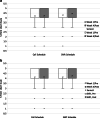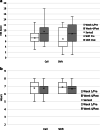Learner Preference of Schedule Type Improves Engagement of Pediatric Residents: Results of a Mixed-Methods Analysis
- PMID: 34457823
- PMCID: PMC8368307
- DOI: 10.1007/s40670-020-01036-6
Learner Preference of Schedule Type Improves Engagement of Pediatric Residents: Results of a Mixed-Methods Analysis
Abstract
Objective: Determine whether a call or shift schedule is better for acquiring optimal knowledge and professionalism, while limiting fatigue for pediatric residents during the pediatric intensive care unit (PICU) rotation in a small residency program.
Methods: This was a prospective, randomized, crossover, mixed-methods study in which pediatric residents were randomized to either a call or shift schedule during their PICU rotation. Attentiveness, bedside care, perceived knowledge, and professionalism were assessed by the resident participants, attending physicians, and nursing staff. Epworth Sleepiness Scale determined the level of resident fatigue. Statistical analysis utilized a t test of unequal variances. Two focus groups were conducted of resident non-participants and participants. Graduated resident participants and non-participants were surveyed via anonymous e-mail responses.
Results: Thirty residents participated in the study and twenty residents were surveyed and participated in a focus group. No major differences were detected between each participating group, whether assigned to a call or shift schedule in regard to perceived knowledge, professionalism, or fatigue. Overall themes from qualitative analysis identified advantages and disadvantages for both work schedules. Participants recognized a learner preference for schedule type depending on level of training, suggesting a shift schedule for junior residents and a call schedule for senior residents.
Conclusions: There is no difference between the call or shift schedule in regard to residents' perceived knowledge, professionalism, and fatigue. Participants expressed learner preferences for one schedule over the other, recommending the shift schedule during the PGY-2 year and the call schedule during the PGY-3 year.
Keywords: Call; PICU; Resident physician; Shift; Work hours.
© International Association of Medical Science Educators 2020.
Conflict of interest statement
Conflict of InterestThe authors declare that they have no conflict of interest.
Figures


Similar articles
-
Patient safety, resident well-being and continuity of care with different resident duty schedules in the intensive care unit: a randomized trial.CMAJ. 2015 Mar 17;187(5):321-9. doi: 10.1503/cmaj.140752. Epub 2015 Feb 9. CMAJ. 2015. PMID: 25667258 Free PMC article. Clinical Trial.
-
A 360 degrees evaluation of a night-float system for general surgery: a response to mandated work-hours reduction.Curr Surg. 2004 Sep-Oct;61(5):445-51. doi: 10.1016/j.cursur.2004.03.013. Curr Surg. 2004. PMID: 15475093
-
Evaluation of a pediatric intensive care residency curriculum.Crit Care Med. 1997 Nov;25(11):1898-903. doi: 10.1097/00003246-199711000-00031. Crit Care Med. 1997. PMID: 9366776
-
The effect of the 16-hour intern workday restriction on surgical residents' in-hospital activities.J Surg Educ. 2013 Nov-Dec;70(6):800-5. doi: 10.1016/j.jsurg.2013.02.001. Epub 2013 Apr 9. J Surg Educ. 2013. PMID: 24209659 Review.
-
Effect of January vacations and prior night call status on resident ABSITE performance.J Surg Educ. 2013 Nov-Dec;70(6):720-4. doi: 10.1016/j.jsurg.2013.06.013. Epub 2013 Jul 12. J Surg Educ. 2013. PMID: 24209647 Review.
References
-
- Accreditation Council for Graduate Medical E. The ACGME 2011 Duty hour standards: enhancing quality of care, supervision, and resident professional development. 2011. https://www.acgme.org. Accessed Feb 2020.
-
- Bilimoria KY, Chung JW, Hedges LV, Dahlke AR, Love R, Cohen ME, Hoyt DB, Yang AD, Tarpley JL, Mellinger JD, Mahvi DM, Kelz RR, Ko CY, Odell DD, Stulberg JJ, Lewis FR. National cluster-randomized trial of duty-hour flexibility in surgical training. N Engl J Med. 2016;374(8):713–727. doi: 10.1056/NEJMoa1515724. - DOI - PubMed
-
- Desai SV, Asch DA, Bellini LM, Chaiyachati KH, Liu M, Sternberg AL, Tonascia J, Yeager AM, Asch JM, Katz JT, Basner M, Bates DW, Bilimoria KY, Dinges DF, Even-Shoshan O, Shade DM, Silber JH, Small DS, Volpp KG, Shea JA, iCOMPARE Research Group Education outcomes in a duty-hour flexibility trial in internal medicine. N Engl J Med. 2018;378(16):1494–1508. doi: 10.1056/NEJMoa1800965. - DOI - PMC - PubMed
-
- Accreditation Council for Graduate Medical E. ACGME Common Program Requirements. 2017. [Available from: https://www.acgme.org. Accessed February 2020.
LinkOut - more resources
Full Text Sources
Miscellaneous
